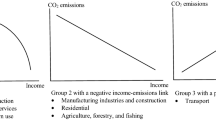Abstract
This study investigates the validity of the EKC (environmental Kuznets curve) hypothesis for the 50 US states and a Federal District (Washington, D.C.). To this aim, the common correlated effects (CCE) and the augmented mean group (AMG) estimation procedures are applied between 1980 and 2015. While the CCE estimation does not support EKC hypothesis, the AMG does. The empirical findings of the AMG estimation indicate that only 14 states verify the EKC hypothesis. Additionally, the expected negative impacts of fossil energy consumption on the environment (CO2 emissions) are strongly detected in all states except Texas. However, the expected positive impacts of renewable energy consumption on the CO2 emissions are detected only in 13 states. Furthermore, the expected negative impacts of the population are not detected in some mostly populated states like New York, Texas, and Ohio. The overall findings of this study may help the US state-level policy makers in two ways: first, to understand whether their economic growths are sustainable (eco-friendly); second, to see how their fossil and renewable energy consumptions affect their environments and to review their energy policies.

Similar content being viewed by others
References
Acaravci A, Ozturk I (2010) On the relationship between energy consumption, CO2 emissions and economic growth in Europe. Energy 35(12):5412–5420
Aldy JE (2005) An environmental Kuznets curve analysis of US state-level carbon dioxide emissions. J Environ Dev 14(1):48–72
Apergis N, Christou C, Gupta R (2017) Are there environmental Kuznets curves for US state-level CO2 emissions? Renew Sust Energ Rev 69:551–558
Apergis N, Ozturk I (2015) Testing environmental Kuznets curve hypothesis in Asian countries. Ecol Indic 52(2015):16–22
Atasoy BS (2017) Testing the environmental Kuznets curve hypothesis across the US: evidence from panel mean group estimators. Renew Sust Energ Rev 77:731–747
Boluk G, Mert M (2015) The renewable energy, growth and environmental Kuznets curve in Turkey: an ARDL approach. Renew Sust Energ Rev 52:587–595
Breusch TS, Pagan AR (1980) The Lagrange multiplier test and its applications to model specification in econometrics. Rev Econ Stud 47:239–253
Chen PY, Chen ST, Hsu CS, Chen CC (2016) Modeling the global relationships among economic growth, energy consumption and CO2 emissions. Renew Sust Energ Rev 65:420–431
Census (2019). US Census Bureau. https://www.census.gov/data.html. Accessed 04/12/2018
Destek MA, Ulucak R, Dogan E (2018) Analyzing the environmental Kuznets curve for the EU countries: the role of ecological footprint. Environ Sci Pollut Res 25:29387–29396
Dogan E, Seker F, Bulbul S (2017) Investigating the impacts of energy consumption, real GDP, tourism and trade on CO2 emissions by accounting for cross-sectional dependence: a panel study of OECD countries. Curr Issue Tour 20(16):1701–1719
Dogan E, Turkekul B (2016) CO2 emissions, real output, energy consumption, trade, urbanization and financial development: testing the EKC hypothesis for the USA. Environ Sci Pollut Control Res 23(2):1203–1213
Dogan E, Seker F (2016a) Determinants of CO2 emissions in the European Union: the role of renewable and non-renewable energy. Renew Energy 94:429–439
Dogan E, Seker F (2016b) The influence of real output, renewable and non-renewable energy, trade and financial development on carbon emissions in the top renewable energy countries. Renew Sust Energ Rev 60:1074–1085
Eberhardt M, Bond S (2009) Cross-section dependence in nonstationary panel models: a novel estimator, MPRA Paper 17692. University Library of Munich, Germany
EIA, (2019). U.S. Energy Information Administration. https://www.eia.gov/. Accessed 04/12/2018
Esteve V, Tamarit C (2012) Is there an environmental Kuznets curve for Spain? Fresh evidence from old data. Econ Model 29(6):2696–2703
Farhani S, Mrizak S, Chaibi A, Rault C (2014) The environmental Kuznets curve and sustainability: a panel data analysis. Energy Policy 71:189–198
FED, (2019). (Federal Reserve Bank of St. Louis). https://research.stlouisfed.org/. Accessed 04/12/2018
Franklin RS, Ruth M (2012) Growing up and cleaning up: the environmental Kuznets curve redux. Appl Geogr 32(1):29–39
Friedl B, Getzner M (2003) Determinants of CO2 emissions in a small open economy. Ecol Econ 45(1):133–148
Grossman, G. M., and Krueger, A. B. (1991). Environmental impact of a North American Free Trade Agreement. NBER Working paper, 3914.
Grossman GM, Krueger AB (1995) Economic growth and the environment. Q J Econ 110:353–377
Halicioglu F (2009) An econometric study of CO2 emissions, energy consumption, income and foreign trade in Turkey. Energy Policy 37(3):1156–1164
He J, Richard P (2010) Environmental Kuznets curve for CO2 in Canada. Ecol Econ 69(5):1083–1093
Heidari H, Katircioğlu ST, Saeidpour L (2015) Economic growth, CO2 emissions, and energy consumption in the five ASEAN countries. Int J Electr Power Energy Syst 64:785–791
Herzer D, Vollmer S (2012) Inequality and growth: evidence from panel cointegration. J Econ Inequal 10:489–503
Hettige H, Lucas REB, Wheeler D (1992) The toxic intensity of industrial production: global patterns, trends, and trade policy. Am Econ Rev 82:478–481
Işik C (2010) Natural gas consumption and economic growth in Turkey: a bound test approach. Energy Syst 1(4), 441–456
Işık C, Shahbaz M (2015) Energy consumption and economic growth: a panel data aproach to OECD countries. International Journal of Energy Science 5(1), 1–5
Isik C, Kasımatı E, Ongan S (2017) Analyzing the causalities between economic growth, financial development, international trade, tourism expenditure and/on the CO2 emissions in Greece. Energy Sources, Part B: Economics, Planning, and Policy 12(7):665–673
Isik C. Radulescu M (2017) Investigation of the relationship between renewable energy, tourism receipts and economic growth in Europe. Statistika-Statistics and Economy Journal 97(2), 85–94
Isik C, Dogru T, Turk ES (2018) A nexus of linear and non‐linear relationships between tourism demand, renewable energy consumption, and economic growth: Theory and evidence. Int J Tour Res 20(1), 38–49
Isik C, Ongan S, Ozdemir D (2019) Testing the EKC hypothesis for ten US states: an application of heterogeneous panel estimation method. Environ Sci Pollut Res 26:10846–10853 1-8
Jobert T, Karanfil F, Tykhonenko A (2014) Estimating country-specific environmental Kuznets curves from panel data: a Bayesian shrinkage approach. Appl Econ 46(13):1449–1464
Kuznets S (1955) Economic growth and income inequality. Am Econ Rev 65(1):1–28
Lindmark M (2002) An EKC-pattern in historical perspective: carbon dioxide emissions, technology, fuel prices and growth in Sweden 1870–1997. Ecol Econ 42(1):333–347
Nasreen S, Anwar S, Ozturk I (2017) Financial stability, energy consumption and environmental quality: evidence from South Asian economies. Renew Sust Energ Rev 67:1105–1122
Narayan PK, Narayan S (2010) Carbon dioxide emissions and economic growth: panel data evidence from develo** countries. Energy Policy 38(1):661–666
Ozokcu S, Ozdemir O (2017) Economic growth, energy, and environmental Kuznets curve. Renew Sust Energ Rev 72(2017):639–647
Panayotou T (1993) Empirical tests and policy analysis of environmental degradation at different stages of economic development,’ Working Paper WP238, Technology and Employment Programme. International Labor Office, Geneva
Panayotou T (1995) Environmental degradation at different stages of economic development. In: Ahmed I, Doeleman JA (eds) Beyond Rio (The environmental crisis and sustainable livelihoods in the third world). International Labor Organization, Macmillan Press Ltd., London
Pesaran, M. H (2004). General diagnostic tests for corss section dependence in panels. IZA Discussion Paper, 1240.
Pesaran MH (2006) Estimation and inference in large heterogeneous panels with a multifactor error structure. Econometrica 74(4):967–1012
Pesaran MH (2007) A simple panel unit root test in the presence of cross-section dependence. J Appl Econ 22:265–312
Roca J, Padilla E, Farré M, Galletto V (2001) Economic growth and atmospheric pollution in Spain: discussing the environmental Kuznets curve hypothesis. Ecol Econ 39(1):85–99
Selden TM, Song D (1994) Environmental quality and development: is there a Kuznets curve for air pollution emissions? J Environ Econ Manag, XXVII 27:147–162
Stern DI, Common MS, Barbier EB (1996) Economic growth and environmental degradation: the environmental Kuznets curve and sustainable development. World Dev 24(7):1151–1160 Great Britain: Elsevier Science Ltd
Vincent, J. (1996). Pollution and economic development in natural resources, environment and development, in Malaysia: a economic perspective, by Jeffrey Vincent, Rozali bin Mohamed Ali, and Associates.
Author information
Authors and Affiliations
Corresponding author
Additional information
Responsible editor: Eyup Dogan
Publisher’s note
Springer Nature remains neutral with regard to jurisdictional claims in published maps and institutional affiliations.
Rights and permissions
About this article
Cite this article
Isik, C., Ongan, S. & Özdemir, D. The economic growth/development and environmental degradation: evidence from the US state-level EKC hypothesis . Environ Sci Pollut Res 26, 30772–30781 (2019). https://doi.org/10.1007/s11356-019-06276-7
Received:
Accepted:
Published:
Issue Date:
DOI: https://doi.org/10.1007/s11356-019-06276-7
Keywords
- Environmental Kuznets curve (EKC)
- Fossil and renewable energy consumptions
- Cross-sectional dependence
- CCE
- AMG




